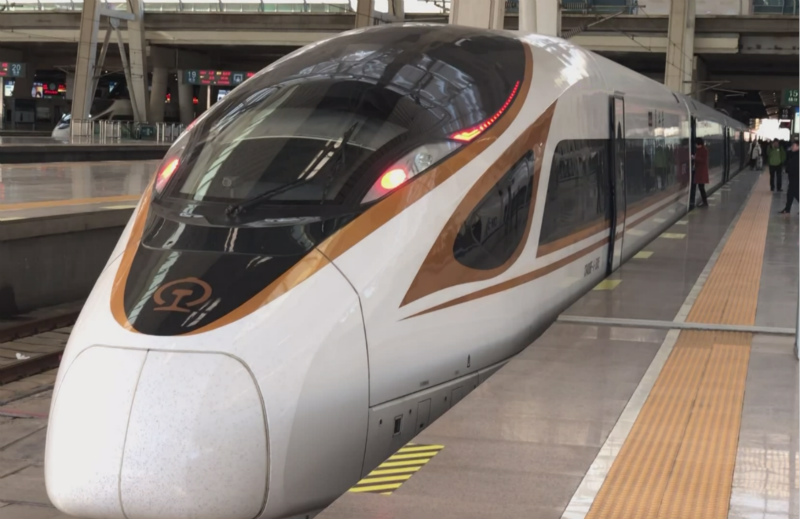


The Spring Festival travel rush, known as Chunyun (春运) in Chinese, is famously known as the largest annual migration on earth. It takes place over a 40-day window, this year from the 21st January to the 1st of March, when people from all corners of China travel to their hometowns to spend the Chinese Lunar New Year with their families.
This year, an expected three billion journeys will be made over the Spring Festival travel rush window, and authorities have rolled out a number of measures to increase efficiency and make the process easier for everyone involved.
In a bid to ease congestion and keep up with a growing number of travellers, at least ten new railway lines opened last year and more Fuxing bullet trains, the country’s most advanced high-speed train, have been deployed on the nation’s railways, increasing the capacity of railway transportation by 5.3 percent.
Aside from increasing capacity, authorities have introduced new technologies to improve efficiency during the travel rush. Gao Yujie, Director of the Communication Department at Beijingnan Railway Station, explained, “This year, passengers have access to faster security checks, faster check-in, and speedier ticket purchase and collection. For faster ticket collection, we upgraded 80 of the automatic ticket machines in our station before the travel rush, which are twice as fast as the older generations.”
“We’ve also applied a real-name face scan check-in system for the Beijing – Tianjin intercity bullet trains. This has increased check-in efficiency by 100 percent. Now it only takes two seconds to scan your face and pass through the gate,” he added.
This year, 60 percent of the trains departing from Beijingnan Railway Station are Fuxing bullet trains. To see how quick and easy the process of getting home now is, I head down to Beijingnan Railway Station to hop on a 16-car Fuxing train, with a passenger capacity of 1,193 people and a maximum speed of 350 km/h.
On arrival to Beijingnan Railway Station, I head over to the ticket booth to collect my pre-booked tickets. You can prebook tickets all over China using a range of apps - I usually use WeChat, which allows me to book in English using WeChat pay.
As I’m a foreigner, I have to go to the ticket counter to collect my tickets, but as most Chinese passengers use the new ticket machines, there’s no queue, and I hand over my reservation number and passport, receiving my tickets in a matter of seconds.
Although getting from one side of the station to the other is a struggle due to throngs of people queuing, suitcases and children passing the time playing games, as soon as I move through the gate, the platform is calm, and it's easy to board, find my seat and settle in for the ride.
While on my way to get a quick snack on board, I bump into Guan Mian, a bullet train conductor for China Railway Beijing Group Co., Ltd., who explained, “Many passengers specifically chose the Fuxing bullet train as their means of transport to get home. They purchased their tickets many days in advance to make sure they could experience the Fuxing journey with their family before getting home for Spring Festival celebrations.”
Onboard, passengers can now also connect to free wifi. The “Zhangshanggaotie” app has so far covered 274 Fuxing bullet trains, providing free WiFi to about 500,000 passengers every day while ensuring the safety of personal information.
Besides free WiFi, the “Zhangshanggaotie” app has another six features including a car-hailing service and a station map service, giving passengers the ability to plan their journey even after they disembark the bullet train.
It's evident that recent upgrading has made my journey more convenient from start to finish, and it’s hoped that these changes will make the whole 40 days run smoother for everyone racing to spend Spring Festival at home.
"We wish all our passengers a safe and smooth trip back home. We wish you a great year of the pig and a happy Spring Festival," said Guan.

 Award-winning photos show poverty reduction achievements in NE China's Jilin province
Award-winning photos show poverty reduction achievements in NE China's Jilin province People dance to greet advent of New Year in Ameiqituo Town, Guizhou
People dance to greet advent of New Year in Ameiqituo Town, Guizhou Fire brigade in Shanghai holds group wedding
Fire brigade in Shanghai holds group wedding Tourists enjoy ice sculptures in Datan Town, north China
Tourists enjoy ice sculptures in Datan Town, north China Sunset scenery of Dayan Pagoda in Xi'an
Sunset scenery of Dayan Pagoda in Xi'an Tourists have fun at scenic spot in Nanlong Town, NW China
Tourists have fun at scenic spot in Nanlong Town, NW China Harbin attracts tourists by making best use of ice in winter
Harbin attracts tourists by making best use of ice in winter In pics: FIS Alpine Ski Women's World Cup Slalom
In pics: FIS Alpine Ski Women's World Cup Slalom Black-necked cranes rest at reservoir in Lhunzhub County, Lhasa
Black-necked cranes rest at reservoir in Lhunzhub County, Lhasa China's FAST telescope will be available to foreign scientists in April
China's FAST telescope will be available to foreign scientists in April